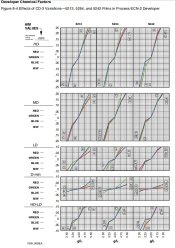I used to develop a lot of ECN-2 (as 35mm still film), and after a fairly long hiatus, I am getting back into it.
I am finding that if I mix the Kodak developer formula by the book, and use standard developing times and temperatures, the results are thin (e.g., film leader is not dark enough, negatives are thin). I know that I had had similar results when I was doing a lot of this, and one of the things I did was to increase the amount of CD3 from 4g/L to 5.4 g/L. I also experimented with development times.
Has anyone else had a similar experience? I am thinking that the ECN-2 developer may not be ideally suited to the small tank environment. The film I am testing right now is admittedly a bit old -- Vision 320T -- so I expect speed loss -- but it's the leader that bothers me. I will try again this weekend with the CD3 boost and longer development times..but am I the only one to have experienced this? (Please, no generic comments on how awful expired film is, etc. etc.....it's not that).
I am finding that if I mix the Kodak developer formula by the book, and use standard developing times and temperatures, the results are thin (e.g., film leader is not dark enough, negatives are thin). I know that I had had similar results when I was doing a lot of this, and one of the things I did was to increase the amount of CD3 from 4g/L to 5.4 g/L. I also experimented with development times.
Has anyone else had a similar experience? I am thinking that the ECN-2 developer may not be ideally suited to the small tank environment. The film I am testing right now is admittedly a bit old -- Vision 320T -- so I expect speed loss -- but it's the leader that bothers me. I will try again this weekend with the CD3 boost and longer development times..but am I the only one to have experienced this? (Please, no generic comments on how awful expired film is, etc. etc.....it's not that).







